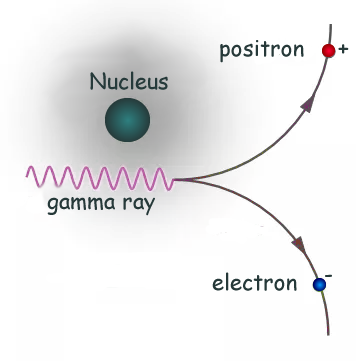Pair Production Pair production occurs when a gamma (γ) ray photon interacts with any atom. Pair production is the creation of a subatomic particle and its antiparticle from a neutral boson. Examples include creating an electron and a positron, a muon and an antimuon, or a proton and an antiproton, but pair production usually refers specifically to a gamma photon creating an electron–positron pair near a nucleus.
For pair production to occur, the incoming energy of the photon must be above a threshold of at least the total rest mass energy of the two particles, and the situation must conserve both energy and momentum. The probability of pair production in photon–matter interactions increases with photon energy and also increases approximately as the square of atomic number of the nearby atom.
The anti-proton was first 'made' in 1955 at the University of California. If a high-energy proton is made to collide with a stationary proton the kinetic energy it possesses can be converted into a matter/anti-matter pair. Just as on annihilation of matter and anti-matter energy is produced, so pure energy can be changed into matter and anti-matter (2mp would be needed). More recently anti-hydrogen was made (an anti-proton and a positron) Amazing! - 'something material' comes out of 'nothing but pure energy', but it has to appear in such a way that if the process reversed we would wind up with the pure energy again. That is why particles that 'come out of thin air' are always produced in pairs. This is termed pair production. The more massive the particle to be produced the greater the energy required ( you may find it interesting to look up particle accelerators at this point in the course). Energy for a collision can be provided by an electric fieldA 2000V field used to accelerate an electron at rest (or a proton - they both have the same charge!) to give it 2keV of kinetic energy; a 6MV field would accelerate an electron at rest to give it 6MeV of kinetic energy; a 9GV field would accelerate an electron at rest to give it 9GeV of kinetic energy etc. If a very high energy proton (enough excess to be converted into a proton and an anti-proton) 'interacts with' (better expression than 'bumps into') an anti-proton of equal energy, then as well as the two original particles there would be another proton/anti-proton pair produced.... the kinetic energy would be converted into matter rather than remaining as energy. Rest mass energy (the energy needed to produce a proton or anti-proton particle at rest!) of a proton is 940MeV. So, to produce a pair we would need 2x940 MeV = 1900 MeV = 1.9 GeV (NB - 2 sig figs here!) If we used a 3.0 GeV accelerator we would have 1.1 GeV left over.... this would be seen as kinetic energy among the particles as there would not be enouh to 'make' a pair.
|
Follow me...
|






